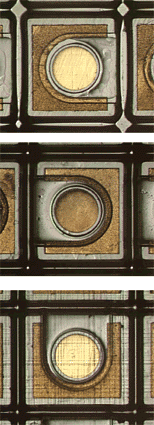|
| |
Liquid analyzer
-
The developed LEDs are advantageous also for liquid analysis
because of broad band absorption of the latter one. For example, water can be optically
detected when utilizing strong absorption band near 3
μm with
FWHM of about 0.8 μm. In the water monitor prototype
differential scheme utilizing LED with two chips mounted together on one TO-18 header
emitting at 3 μm (sample beam) and 3.9 μm
(reference beam) correspondingly have been used. Both LED beams passed through ~300
μm thick liquid cell and were received by a PbSe detector. The
calculated resolution was ~ 0.01% H2O which was far below our sample
concentrations (0.5% and 2% of water in oil). On increasing the water content in oil from
0.5% to 2% the sample/reference signal ratio was decreasing from 0.97 to 0.67
correspondingly indicating possibility to measure humidity of nearly "dry"
liquids (c<<0.1%) [1].
-
-
Other possibilities arise from the use of
flip-chip LEDs and detectors coupled with fibres [2, 3, 4]:



Schematic of the evanescent
wave sensor with LED-PD pair Schematic of mounting process and photos of typical flip-chip LED/PD chips.
-
[1] B.A. Matveev, G.A. Gavrilov, V.V. Evstropov, N.V. Zotova, S.A. Karandashov, G.Yu. Sotnikova, N.M. Stus', G.N. Talalakin and J. Malinen, "Mid-infrared (3-5 μm) LEDs as
sources for gas and liquid sensors", Sensors and Actuators, B 38-39, (1997) 339-343
-
[2]
B. A. Matveev, N.V.Zotova, S. A. Karandashev, M. A. Remennyi, N. M. Stus'
and G.N.Talalakin “3.4
mm
“Flip-chip” LEDs for Fiber Optic Liquid Sensing” Proceedings of the 1-st
International CONFERENCE on ADVANCED OPTOELECTRONICS and LASERS (CAOL'2003),
September 16-20, 2003, Alushta, Crimea,
Ukraine
v.2, pp138-140
-
[4]
S.McCabe
and B.D.MacCraith, “Novel mid-infrared LED as a source for optical fibre gas
sensing”, Electron. Lett., vol. 29, pp.1719-1721 (1993)
|